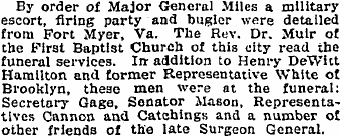John B. Hamilton (1847-1898) was the U.S. Surgeon General from 1879 to 1891.
Hamilton was born on December 1, 1847 at Otter Creek, Jersey County, Illinois. He was educated at the Hamilton School, operated by his family, and apprenticed at age 16 to physician Joseph O. Hamilton. The following year (1864), Hamilton enlisted in G Company, 61st Illinois Regiment. After the close of the Civil War, he attended Rush Medical College in Chicago (1869, MD) and entered private practice.
Hamilton’s wartime experiences exerted their influence, drawing him from private medical practice into a commission as an Assistant Surgeon in the U.S. Army (1874) and after he resigned from the Army, into the Regular Corps of the Marine Hospital Service (MHS). In 1876, the 24 year old Hamilton sat for the first examination for entrance into MHS, passed with flying colors, and was commissioned as an Assistant Surgeon on Oct 21, 1876. His talent in public health practice revealed itself early, during an 1877 assignment to the Boston Marine Hospital at Chelsea, Massachusetts. Changing land use in the area had blocked hospital sewage from draining properly, causing unexpected outbreaks of infectious disease among patients. Hamilton resolved the crisis successfully by directing a renovation of the facility’s drainage and sewage systems.
On April 3, 1879 Hamilton was appointed Supervising Surgeon General, succeeding fellow Army veteran and Chicagoan Dr. John Woodworth, the first Supervising Surgeon. Woodworth had died in office, amidst a political battle with the fledgling American Public Health Association and its allies in Congress over the possibility that a new National Board of Health would supercede the newly revamped MHS (1871). That MHS outlived the National Board of Health and emerged in the 1890s reinvigorated is a testament to Hamilton’s skills as a political negotiator as well as a bureaucrat. Under his tenure, MHS gained authorities to establish a national quarantine on sea and land (interstate), formal recognition of merit-based requirements for a Commissioned Corps of medical officers, and a new laboratory devoted to bacteriology, the newest public health science of the day.
Two national epidemics framed Hamilton’s tenure: the yellow fever epidemic of 1878 that raged along the Mississippi River Valley and the Asiatic cholera epidemic of 1892, which hit New York City with particular ferocity. Sanitary cordons, or quarantine, were the primary response to yellow fever, to block the progress of disease believed to be conveyed not only on boats and foot traffic but also now by railroad. Instituting quarantines, however, meant Federal intervention into what was widely held to be state police powers and met resistance in the southeastern United States where the issue of yellow fever, and its impact on trade, were most critical.
Advocates of a National Board of Health, including Army Surgeon John Shaw Billings, were spurred to action by the insufficient funding allotted to the Quarantine Act of 1878. Over the following 4 years, Hamilton would press Billings at every turn, in a protracted, ultimately successful effort to regain authorities and recognition of MHS as the central Federal public health agency. When Billings began publishing MHS’s Bulletin under the Board’s auspices, Hamilton countered by persuading Congress to fund new Marine Hospitals in locations like Sitka, Alaska, to strengthen collaboration with the Revenue Cutter Service (predecessor to the U.S. Coast Guard). The Board distributed grants-in-aid to state and territorial health departments for what were called “inland quarantines” but had a mixed record in regulating the uses to which grants were put and made political enemies when it attempted to quell yellow fever by means of a quarantine station on Ship’s Island, Louisiana, near New Orleans.
While the Board struggled with clumsy administrative mechanisms, Hamilton demonstrated how MHS’s relationships with customs inspectors and the Revenue Cutter Service enabled a quick and effective quarantine response to smallpox aboard a Mississippi River steamboat at Fort Benton, Montana Territory (May 1882), and how MHS blocked yellow fever in Mexico from entry into Brownsville, Texas by means of a sanitary cordon hastily assembled around the region. Congress recognized Hamilton’s leadership and in 1882 and 1883 awarded MHS a $100,000 fund for investigating epidemics, monies that had been slated for the Board. When Billings and his colleagues attempted to revive the idea of a National Board as a new Bureau of Health within the Department of the Interior, Hamilton announced that during August 1887 MHS had established a Hygienic Laboratory (predecessor to the National Institutes of Health), where Dr. Joseph Kinyoun and his staff were applying the new science of bacteriology to examine cholera. In the end, the National Board of Health lost both funding and support from Congress, which gave the Board’s enlarged authorities, and its quarantine stations, to MHS.
Issues surrounding the practice of quarantine drove Hamilton’s work in public health. It was no coincidence that the Hygienic Laboratory began in an attic at Staten Island’s Marine Hospital, near Ellis Island, the single busiest port of entry for immigrants during this period. Earlier on, Hamilton had established a Marine Hospital on Bedloe’s Island, future site of the Statue of Liberty. Although MHS would not receive formal authority to issue domestic quarantines until 1893, Hamilton and his staff worked with the Congress to advance incremental changes toward a national policy. Maritime quarantine legislation (Act of August 1, 1888) strengthened the Act of 1878, adding new Federal quarantine stations along the East and West coasts; March 1891 legislation made medical inspection of immigrants part of MHS’s duties; and interstate quarantine legislation (Act of March 27, 1890) gave MHS authority to establish quarantines against epidemic cholera, yellow fever, smallpox, and plague. On the request of his successor, Surgeon General Walter Wyman, Hamilton also returned to New York during the 1892 cholera pandemic, to set up a quarantine camp at Sandy Hook (Camp Low).
Hamilton made limited progress with the Congress realizing Woodworth’s reform plans to set MHS on sound fiscal and professional moorings. The Shipping Act of June 26, 1884 replaced the hospital tax charged to merchant seamen in favor of financing health services by means of a tonnage tax on foreign ships landing in domestic ports, supplemented by deficiency appropriations. And after Hamilton issued regulations specifying competitive examinations for entrance into a corps of medical officers, the Congress formally authorized the Commissioned Corps with the Act of January 4, 1889. But he was not able to win an equal footing for MHS’s Commissioned Corps with the salaries and ranks accorded to military medical officers and as a result, resigned his post as Surgeon General on June 1, 1891.
Hamilton was recommissioned as a Surgeon and assigned to Chicago’s Marine Hospital. Hamilton led a full professional life, serving as a Professor of Surgery at his alma mater, Rush Medical College, and as editor of the new Journal of the American Medical Association (1893-1898). Rather than accept an assignment to San Francisco, Hamilton resigned from MHS on November 13, 1896 and accepted the position of Superintendent of the Illinois State Insane Hospital in Elgin, Illinois. He would end his days at the hospital, dying there on December 24, 1898.
This article was originally based on public domain text written by the U.S. government.
John Brown Hamilton of Illinois
- Appointed from Illinois, Assistant Surgeon, United States Army, 10 November 1874
- Resigned 31 May 1876
- Died 24 December 1898
Presidential Physician: John Brown Hamilton (1847-1898) William McKinley
Presidents: James Garfield – In the first day after assassination shooting: consultant physician.
Education: Degree: MD. School: Rush Medical College, 1869.
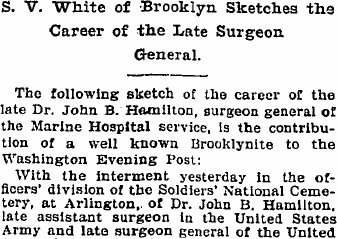
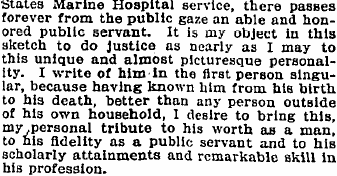
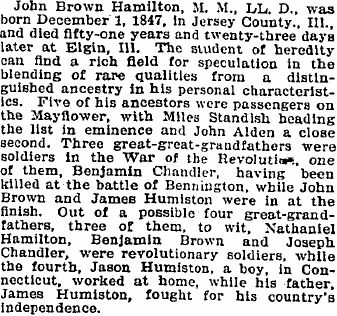
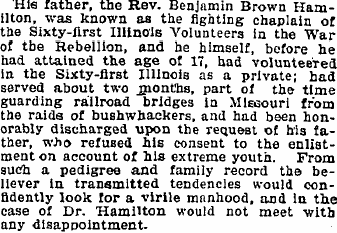
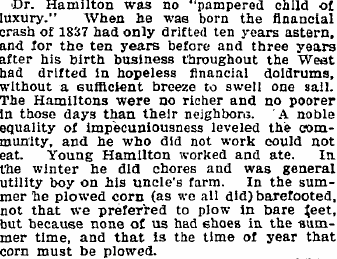
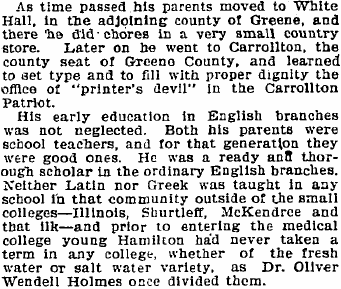
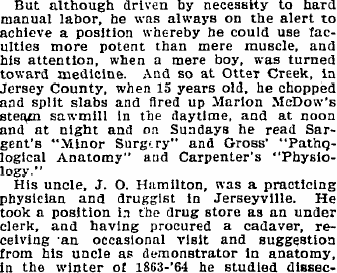
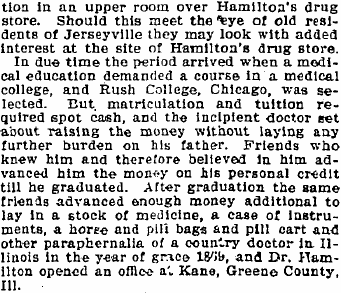
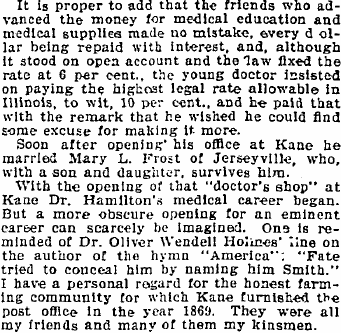
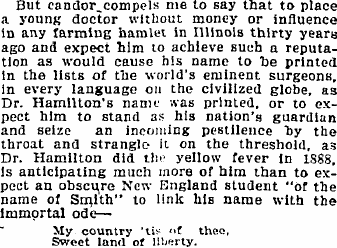
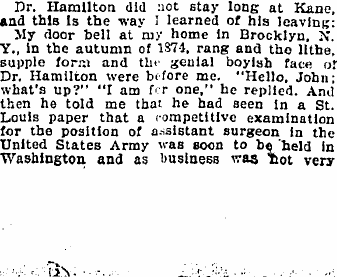
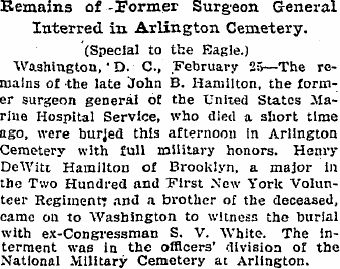
HAMILTON, JOHN BROWN
VETERAN SERVICE DATES: Unknown
DATE OF DEATH: 12/24/1898
DATE OF INTERMENT: Unknown
BURIED AT: SECTION EASTE SITE LT 748
Michael Robert Patterson was born in Arlington and is the son of a former officer of the US Army. So it was no wonder that sooner or later his interests drew him to American history and especially to American military history. Many of his articles can be found on renowned portals like the New York Times, Washingtonpost or Wikipedia.
Reviewed by: Michael Howard

